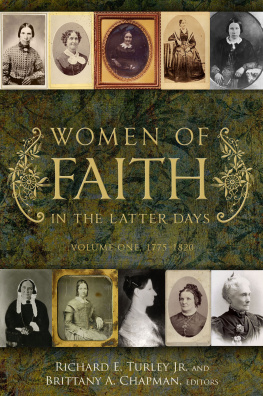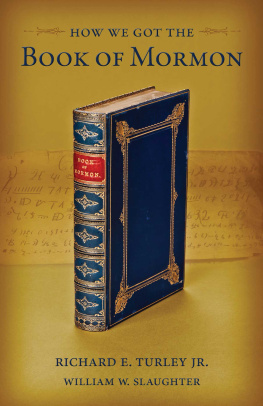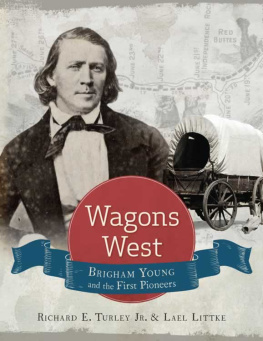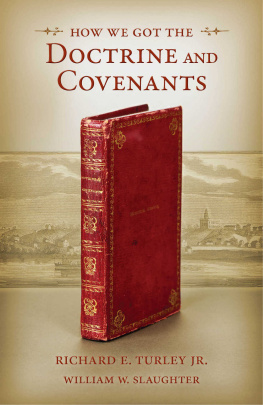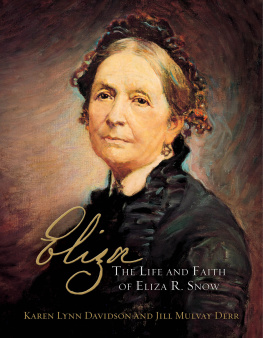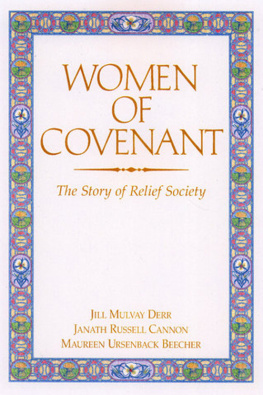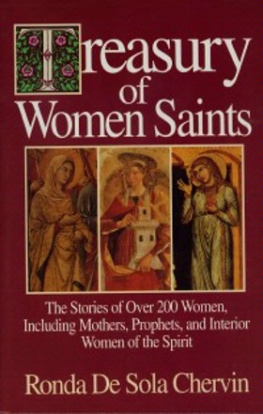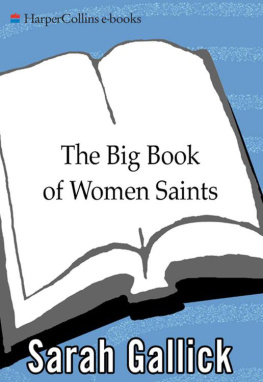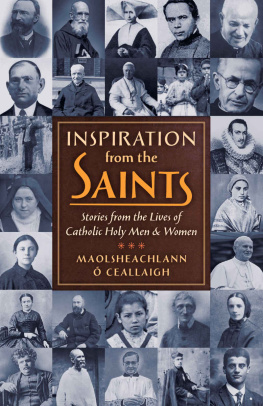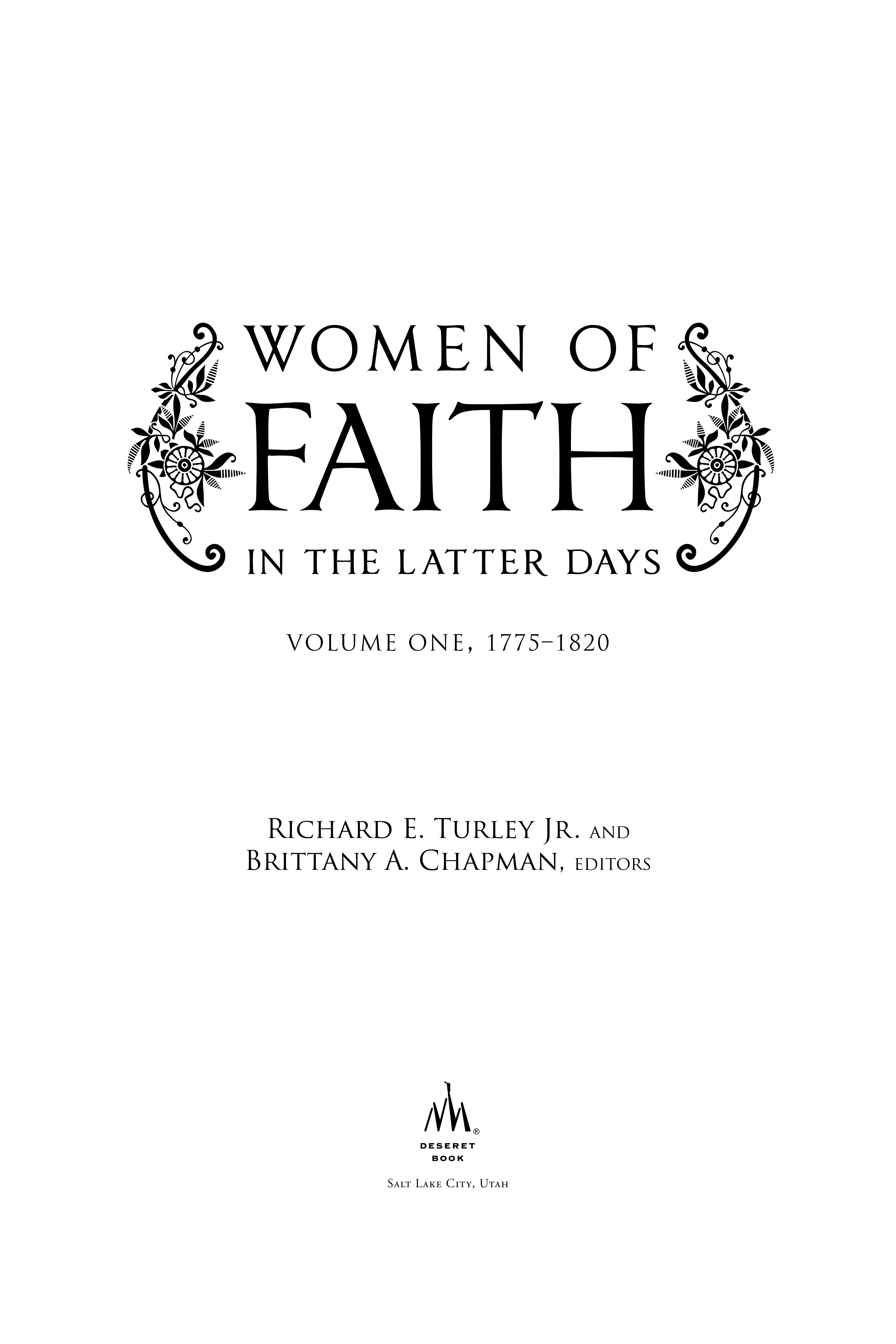2011 Richard E. Turley Jr. and Brittany A. Chapman.
All rights reserved. No part of this book may be reproduced in any form or by any means without permission in writing from the publisher, Deseret Book Company, P.O. Box 30178, Salt Lake City Utah 84130. This work is not an official publication of The Church of Jesus Christ of Latter-day Saints. The views expressed herein are the responsibility of the author and do not necessarily represent the position of the Church or of Deseret Book. Deseret Book is a registered trademark of Deseret Book Company.
Library of Congress Cataloging-in-Publication Data
Women of faith in the latter days. Volume 1, 17751820 / edited by Richard E. Turley Jr. and Brittany A. Chapman.
pages cm
Includes bibliographical references and index.
ISBN 978-1-60641-033-2 (hardbound : alk. paper)
1. Mormon womenBiography. I. Turley, Richard E. (Richard Eyring), 1956 editor. II. Chapman, Brittany A., editor.
BX8693.W66 2011
289.3092'52dc23 2011035215
Printed in the United States of America
Malloy Lithographing Incorporated, Ann Arbor, MI
10 9 8 7 6 5 4 3 2 1
_________________________
Except as noted below, all images are courtesy of the Church History Library, The Church of Jesus Christ of Latter-day Saints, Salt Lake City, Utah. Used by permission.
Images of Abigail Smith Abbott, Drusilla Dorris Hendricks, Sarah De Armon Pea Rich, and Patty Bartlett Sessions, courtesy of International Society Daughters of Utah Pioneers, Salt Lake City, Utah. Used by permission.
Image of Sarah Sturtevant Leavitt statue courtesy of Norene Mackley. Used by permission.
Image of Patience Delila Pierce Palmer courtesy of Eileen Palmer Smith. Used by permission.
Image of Maria Jackson Normington Parker from Annie Hilton Bishop, Sketch of the Life of Maria Jackson Normington Parker, My Mothers Mother, June 1929, public domain.
Image of Mary Bathgate Shelley courtesy of Jay G. Burrup. Used by permission.
Images of Diantha Morley Billings; Elizabeth Lane Hyde; Gwenllian Matthew Marley; Martha Pane Jones Thomas; Margaret Cooper West; courtesy of International Society Daughters of Utah Pioneers, Salt Lake City, Utah. Used by permission.
Image of Catherine Clark Smith Harrison courtesy of Linda G. Birch. Used by permission.
Image of Myra Mayall Henrie courtesy of Donna Toland Smart. Used by permission.
Image of Mary Ann Weston Maughan courtesy of Merrill-Cazier Library, Special Collections, Utah State University, Logan, Utah. Used by permission.
Image of Margaret Ann Howard McBride courtesy of Julie Barker Farr. Used by permission.
Image of Mary Presdee Phillips courtesy of Jay G. Burrup. Used by permission.
For the women upon whose
shoulders we stand
Introduction to the Series
Although approximately half the people in the history of The Church of Jesus Christ of Latter-day Saints have been women, their lives of faith and dedication are just beginning to receive the attention they merit. This series, Women of Faith in the Latter Days, aims to enhance awareness of these women through inspirational accounts written for a general readership.
The seven volumes projected for the series will be arranged as follows:
Volume 1: Women born between 1775 and 1820
Volume 2: Women born between 1821 and 1845
Volume 3: Women born between 1846 and 1870
Volume 4: Women born between 1871 and 1895
Volume 5: Women born between 1896 and 1920
Volume 6: Women born between 1921 and 1945
Volume 7: Women born between 1946 and 1970
Within each volume, the chapters are arranged alphabetically by the last name of each woman of faith.
We have sought to balance the preferences of general readers with the needs of scholarship by following common editorial conventions that enhance ease of reading but preserve the accuracy of historical sources and the personalities of the subject women. Briefly stated, in the historical sources we have preserved the original spelling and grammar, using square brackets [ ] to expand, correct, or clarify when necessary for readability. We have silently added punctuation and capitalized the first words of sentences, using our best interpretive judgment to discern the writers intentions. We have also altered capitalization when failure to do so might prove distracting to readers.
We have included chapters written by a range of authors, from well-established scholars to beginning writers. Some chapters adopt a scholarly approach, often quoting the subject womans own words at length. Others follow a more popular approach, avoiding long quotations from the subject and replacing them with the authors own prose. Some of the subject women left few or no writings behind, making it difficult or impossible to quote them. Our goal has been to feature a diverse group of women, both those well known to readers and those who lived lives of faith in comparative anonymity.
We hope both scholarly and popular audiences will find value in these volumes. Our intent in producing them is to plant seeds for future work. If our series leads to better scholarly and popular works, we will feel rewarded for our efforts.
We invite you to join with us in celebrating the many Latter-day Saint women whose lives should be an inspiration to readers in the present generation and in generations to come. We hope these volumes will prompt readers to write about their own lives and will lead to longer works about past and present women of faith in the latter days.
Preface
Volume 1 of Women of Faith in the Latter Days features women born before or in 1820. The Church of Jesus Christ of Latter-day Saints traces its beginnings to the revelations of Joseph Smith Jr., a modern prophet of God who experienced visions beginning in the 1820s that led to the formal organization of the Church in 1830. After Joseph experienced his First Vision, he recounted it first to a womanhis mother, Lucy Mack Smith.
When originally organized, the Church was called the Church of Christ. Then in 1834, to distinguish the Church from others similarly named, members attending a conference in Kirtland, Ohio, voted to change the name to the Church of the Latter Day Saints. Yet the new name ran contrary to a Book of Mormon passage in which the Lord Jesus Christ commanded, Ye shall call the church in my name (3 Nephi 27:7). As a result, questions arose about the new name, and in 1838, Joseph Smith announced a new revelation in which the Lord declared: For thus shall my church be called in the last days, even The Church of Jesus Christ of Latter-day Saints (D&C 115:4).
One of Joseph Smiths first revelations was addressed to a womanhis wife, Emma Hale Smith. It directed her to lay aside the things of this world, and seek for the things of a better. Like other Latter-day Saint women, Emma sacrificed greatly because of her faith.
The nineteenth century was a turbulent period for members of the Church. Persecution plagued Joseph Smith from the time he announced his first vision, and guided by Joseph Smiths revelations, the Saints moved to Ohio not long after the Churchs organization. Revelation soon indicated another gathering place for the Saints in Missouri. Religious, economic, political, and cultural differences with settlers in both regions contributed to tensions that ultimately drove many of the Churchs most devout members to Illinois. There mob violence resulted several years later in the murder of Joseph Smith and his brother Hyrum in 1844. Brigham Young led many of the Saints across Iowa in 1846 and to Utah in 1847. Others followed in subsequent decades.

